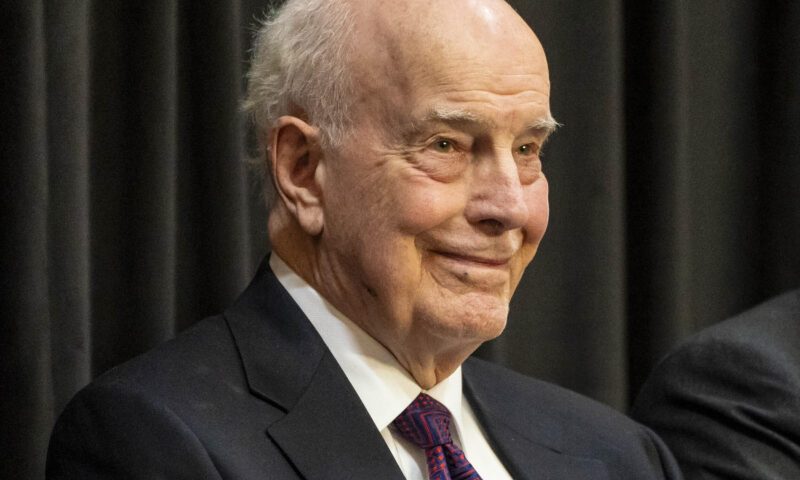Dan Evans’ politics were ‘just right’
(Pictured: Former Washington governor and U.S. senator Dan Evans, at an event in Olympia in April, five months before his death. Photo credit: David Ryder/Cascade PBS)
By Knute Berger
Cascade PBS
In many ways, three-term Washington governor and U.S. senator Dan Evans, who died at age 98 in October, was the Goldilocks politician.
While centrism is out of fashion these days — too often seen as overly compromising or wishy-washy — Evans personified the politics of the “just right” middle. He was a pragmatic progressive Republican, a species once popular in Washington and Oregon.
Evans was also a former engineer who worked on the Alaskan Way Viaduct. He was an Eagle Scout. A devoted family man, he lost his wife of 65 years, Nancy, in January.
Evans seemed to have been around forever. He was only 39 when inaugurated as governor in 1965.
Evans adhered to reality-based decision-making, especially during his three four-year gubernatorial terms (1965-77). He was a fiscal conservative but supported a more equitable tax system. including an income tax. When California began shutting the door to Southeast Asian refugees, Evans opened Washington wide.
An avid outdoorsman, Evans hiked, climbed and was a passionate conservationist. He played major roles in the creation of North Cascades National Park, adding coastline to Olympic National Park and expanding wilderness areas in Washington. The Daniel J. Evans Wilderness in Olympic National Park is named for him.
In the spring of 1973, the youthful, vigorous governor rappelled off the 10-story concrete clock tower on the Evergreen State College campus. As a student journalist at the college, I ran out to watch him in case he fell. Ah, cynicism can come early to those of us in the journalism trade. He rappelled without incident.
In the spring of 2019, Evans led a group of Mainstream Republicans, non-MAGAs for the most part, and some journalists on a hike along the Alpine Wilderness trail. I went along, and Evans’ vigor at age 93 was on full display 46 years after his Evergreen clock stunt.
Evans pulled votes from both parties in elections and from both sides of the aisle in the Legislature. In his era, no politician was more respected, by both Republicans and Democrats. After leaving the governor’s mansion, he served one unsatisfying (for him) term in the U.S. Senate (1983-89) and retired from elective politics. He was frustrated by D.C. gridlock.
In addition to serving as president of Evergreen after he left the governor’s mansion, he became a University of Washington regent and served on many commissions and councils, often credited as a stabilizing and wise presence in regional decisionmaking. The UW’s Evans School of Public Policy and Governance is named for him.
His politics may seem baffling in the modern era of partisanship and division, like a survivor of a near-extinct species. He gave the keynote speech at the 1968 Republican national convention that nominated Richard Nixon or president, although Evans had endorsed liberal Republican Nelson Rockefeller. Evans was a fresh face in the party and continued to be seen that way. He was on Gerald Ford’s short list for vice president in 1976.
Evans didn’t support Donald Trump’s election or re-election bid as president, yet he refused to give up his GOP identity. I once asked him why he didn’t quit a party that had strayed so far from his core values. “Just stubborn, I guess,” he replied.
Evans cultivated GOP moderation in his cabinet as governor and continued to mentor Republicans who hadn’t given up on the possibility of electing common-sense candidates. Electeds like former GOP secretaries of state Ralph Munro, a former Evans aide, and Sam Reed, who fought with his own party over a so-called “stolen” election in 2004, were exemplars of the integrity that Evans represented and cultivated.
“Governor Dan” could get tough, though, especially during his campaign against the Democratic incumbent he defeated in 1964, Albert D. Rosellini. Evans kept above the fray, but his camp floated rumors about the governor’s alleged criminal associations and activities. Nothing was proven, but the allegations might have cost Rosellini a federal appointment after his loss to Evans.
Another campaign eyebrow-raiser, though hardly Evans’ fault: A young, clean-cut volunteer was tasked in 1972 with following Evans’ opponent around, recording his speeches and reporting on his events. That Evans operative’s name was Ted Bundy, before he became infamous as a serial killer.
The Evans era seems like a kind of political fairy tale for those who are nostalgic for saner, more reasonable politics. Too hot, too cold, will we ever find “just right” again? Many who remember those times might yearn for pragmatic decency as an essential criterion for running and holding office. Evans proved those could be winning qualities.
Knute Berger is an editor-at-large for Cascade PBS, a non-profit news organization covering the Pacific Northwest.


